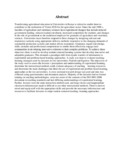| dc.description.abstract | Transforming agricultural education in Universities in Kenya is critical to enable them to contribute to
the realization of Vision 2030 for the agriculture sector. Since the mid 1980’s, faculties of agriculture
and veterinary sciences have experienced changes that include reduced government funding, reduced
student enrolment, increased competition for students, and changes in the role of government as the
traditional employer for graduates of agriculture and veterinary sciences. Universities must therefore
31
respond to these changes by designing relevant and responsive curricula using appropriate delivery
methods responsive to the changing demands of sustainable production systems and market driven
economies. Graduates require knowledge, skills, attitudes and professional competencies to enable
them effectively engage rural communities in developing innovative solutions to their complex
problems. To achieve these objectives there is need to develop student centered learning systems that
develop innovative and adaptable graduates. This demands a paradigm shift from dyadic transfer of
information to experiential and problem-based learning approaches. A study was done to evaluate
teaching-learning strategies used by lecturers in two universities, Nairobi and Egerton. The objectives
of the study were to assess the lecturer’s perceptions and understanding of experiential learning,
determine the instructional methods used, evaluate adequacy of teaching – learning resources,
and determine the main challenges that limit the use of experiential and problem based learning
approaches at the two universities. A cross sectional research design was used and data was collected
using questionnaires and document analysis. Majority of the lecturers had no formal training on
teaching methodologies, were not aware of the contents of the ISO 9001:2008 document on teaching
standards and had differing understandings of experiential learning. Further, lectures were the main
instruction method used, and large classes and inappropriate classroom infrastructure made it difficult
to use other instructional methods. There is need to retool and equip staff with the appropriate skills
and provide the necessary infrastructure and resources to facilitate lecturers to adapt student centered
teaching- learning approaches. | en_US |

